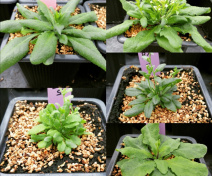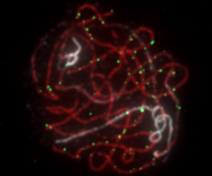Eukaryotic sexual reproduction relies on two complementary events: the production of haploid cells (eventually differentiating into gametes) and fertilization, which restores the original number of chromosomes of the species by the fusion of two gametes.
Meiosis is the cellular division during which haploid cells are generated. Using complementary approaches of genetics, molecular biology, biochemistry, bio-informatics and cellular imaging performed on several model plant species, our MeioMe team studies the mechanisms involved during this crucial step of sexual reproduction.
Biological Question
Meiosis represents a crucial step in the life cycle of organisms that reproduce sexually. This specialised cellular division halves the number of chromosomes, compensating for the chromosome doubling occurring during fertilisation. It is during meiosis that genetic recombination takes place, a process driving the diversification of species and their evolution. While the progression of meiosis has been well described, a large number of its underlying mechanisms remain poorly understood, notably in the case of polyploid species, which experienced whole genome duplications. Numerous questions remain unsolved: Why and how are the rates of meiotic recombination constrained? How are the formation and the distribution of recombination events along chromosomes controlled? Why are pericentromeric regions recombination-defective? How do homologous chromosomes and later sister chromatids separate during the two successive rounds of chromosome segregations that occur at meiosis? How do polyploid species deal with the presence of several related genomes? To what extent has polyploidy contributed to enrich the meiotic “tool box”? How can we use our knowledge of meiotic processes to improve plant breeding programs?
Meiosis represents a crucial step in the life cycle of organisms that reproduce sexually. This specialised cellular division halves the number of chromosomes, compensating for the chromosome doubling occurring during fertilisation. It is during meiosis that genetic recombination takes place, a process driving the diversification of species and their evolution. While the progression of meiosis has been well described, a large number of its underlying mechanisms remain poorly understood, notably in the case of polyploid species, which experienced whole genome duplications. Numerous questions remain unsolved: Why and how are the rates of meiotic recombination constrained? How are the formation and the distribution of recombination events along chromosomes controlled? Why are pericentromeric regions recombination-defective? How do homologous chromosomes and later sister chromatids separate during the two successive rounds of chromosome segregations that occur at meiosis? How do polyploid species deal with the presence of several related genomes? To what extent has polyploidy contributed to enrich the meiotic “tool box”? How can we use our knowledge of meiotic processes to improve plant breeding programs?
Models, tools and methods
To tackle these issues, we are working on several complementary plant species: the model plant Arabidopsis thaliana, rapeseed (Brassica napus) and Camelina (Camelina sativa). Arabidopsis is an important model species in the study of meiosis, due to the possibility of setting up large genetic screens, and the wide diversity of genetic, molecular and cytological tools available. Rapeseed and Camelina are allopolyploid species (polyploid products of interspecific hybridisation events) belonging to the same family as Arabidopsis. Our projects rely on complementary and multi-disciplinary approaches involving genomics, biochemistry, bioinformatics and cytogenetics.
To tackle these issues, we are working on several complementary plant species: the model plant Arabidopsis thaliana, rapeseed (Brassica napus) and Camelina (Camelina sativa). Arabidopsis is an important model species in the study of meiosis, due to the possibility of setting up large genetic screens, and the wide diversity of genetic, molecular and cytological tools available. Rapeseed and Camelina are allopolyploid species (polyploid products of interspecific hybridisation events) belonging to the same family as Arabidopsis. Our projects rely on complementary and multi-disciplinary approaches involving genomics, biochemistry, bioinformatics and cytogenetics.
Societal and economical impacts
The development of new and improved crops, to meet changing societal and environmental demands, is based on new genetic associations. Gaps in our understanding and the ability to control meiotic mechanisms are some of the factors limiting the acceleration of contemporary plant breeding programs. Given the central role of meiosis in the reproduction of eukaryotes, the knowledge generated by our work also has repercussions on the understanding of genome stability defects encountered by the human species (cancers, fertility problems). Improving our understanding of the mechanisms of meiosis and meiotic recombination therefore has important implications for agriculture and medicine.

Leader:
Mathilde Grelon












